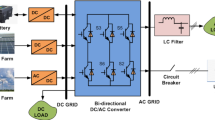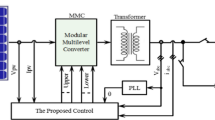Abstract
This paper proposes a bidirectional Z-source dc-dc converter topology for the optimal utilization of renewable energy sources to the microgrid with the proposed control technique. Compared to the existing dc-dc converter circuits, they can reduce in-rush and harmonic current, provide larger range of output dc voltage and improve reliability. It can operate in voltage-fed and current-fed when the place of the source and load is exchanged each other, and it can be perform buck-boost function in these two conditions. Its power flow can be bidirectional. The bidirectional Z-source dc-dc converter is revealed with the consideration of enhanced converter efficiency, effective utilization of renewable energy sources and reduced switching losses. The proposed control technique is the combination of both the grasshopper optimization algorithm (GOA) and local random search (LRS) and hence it is known as GOLRS controller. Here, the searching behaviour of the GOA is enhanced by LRS with the help of two operators named as crossover and mutation. In the proposed technique, the GOLRS is used to generate the optimal gain dataset based on the minimum error objective function and select the exact gain parameter of the PI controller. Batteries are used as an energy source to balance out and allow the renewable power system units to continue running at a steady and stable output power. The proposed technique is executed in the MATLAB/Simulink working platform and compared with various existing techniques.
Similar content being viewed by others
References
A. Belila, E. Berkouk, M. Benbouzid, Y. Amirat, B. Tabbache, and A. Mamoune, “Control methodology and implementation of a Z-source inverter for a stand-alone photovoltaic-diesel generator-energy storage system microgrid,” Electric Power Systems Research, vol. 185, p 106385, 2020.
R. Duan and J. Lee, “High-efficiency bidirectional DC-DC converter with coupled inductor,” IET Power Electronics, vol. 5, no. 1, p. 115, 2012.
X. Zhu and B. Zhang, “High step-up quasi–Z-source DC-DC converters with single switched capacitor branch,” Journal of Modern Power Systems and Clean Energy, vol. 5, no. 4, pp. 537–547, 2017.
A. Lorestani and M. Ardehali, “Optimal integration of renewable energy sources for autonomous tri-generation combined cooling, heating and power system based on evolutionary particle swarm optimization algorithm,” Energy, vol. 145, pp 839–855, 2018.
S. K. Tiwari, B. Singh, and P. Goel, “Design and control of micro-grid fed by renewable energy generating sources,” IEEE Transactions on Industry Applications, vol. 54, no. 3, pp. 2041–2050, 2018.
H. Choi and J. Jung, “Enhanced power line communication strategy for DC microgrids using switching frequency modulation of power converters,” IEEE Transactions on Power Electronics, vol. 32, no. 6, pp. 4140–4144, 2017.
M. Ghahderijani, M. Castilla, A. Momeneh, J. Miret, and L. de Vicuna, “Frequency-modulation control of a DC/DC current-source parallel-resonant converter,” IEEE Transactions on Industrial Electronics, vol. 64, no. 7, pp. 5392–5402, 2017.
N. Saad, A. El-Sattar, and A. Mansour, “A novel control strategy for grid connected hybrid renewable energy systems using improved particle swarm optimization,” Ain Shams Engineering Journal, vol. 9, no. 4, pp. 2195–2214, 2018.
D. Dhua, S. Huang, and Q. Wu, “Optimal power flow modelling and analysis of hybrid AC-DC grids with offshore wind power plant,” Energy Procedia, vol. 141, pp 572–579, 2017.
Z. Xiao, J. Guerrero, J. Shuang, D. Sera, E. Schaltz, and J. Vásquez, “Flat tie-line power scheduling control of grid-connected hybrid microgrids,” Applied Energy, vol. 210, pp. 786–799, 2018.
I. V., L. R., S. V., V. V., P. Siarry, and L. Uden, “Multiobjective optimization and energy management in renewable based AC/DC microgrid,” Computers & Electrical Engineering, vol. 70, pp 179–198, 2018.
R. Ramaprabha and B. Mathur, “Modelling and simulation of solar PV array under partial shaded conditions,” Proc. of IEEE International Conference on Sustainable Energy Technologies, Singapore, pp. 7–11, Nov 2008.
Y. Coughlan, P. Smith, A. Mullane, and M. O’Malley, “Wind turbine modelling for power system stability analysis-A system operator perspective,” IEEE Transactions on Power Systems, vol. 22, no. 3, pp. 929–936, 2007.
M. Ahamed, U. Dissanayake, H. de Silva, H. Pradeep, and N. Lidula, “Modelling and simulation of a solar PV and battery based DC microgrid system,” Proc. of International Conference on Electrical, Electronics, and Optimization Techniques (ICEEOT), Chennai, India, pp. 1706–1711, Mar 2016.
M. Ortega, M. Ortega, F. Jurado, J. Carpio, and D. Vera, “Bidirectional DC-DC converter with high gain based on impedance source,” IET Power Electronics, vol. 12, no. 8, pp. 2069–2078, 2019.
S. Saremi, S. Mirjalili, and A. Lewis, “Grasshopper optimisation algorithm: Theory and application,” Advances in Engineering Software, vol. 105, pp 30–47, 2017.
S. Mirjalili, S. Mirjalili, S. Saremi, H. Faris, and I. Aljarah, “Grasshopper optimization algorithm for multi-objective optimization problems,” Applied Intelligence, vol. 48, no. 4, pp. 805–820, 2017.
D. Duan, X. Ling, X. Wu, and B. Zhong, “Reconfiguration of distribution network for loss reduction and reliability improvement based on an enhanced genetic algorithm,” International Journal of Electrical Power & Energy Systems, vol. 64, pp 88–95, 2015.
S. Prince, K. Panda, V. Kumar, and G. Panda, “Power quality enhancement in a distribution network using PSO assisted Kalman filter — Based shunt active power filter,” Proc. of IEEMA Engineer Infinite Conference (eTechNxT), New Delhi, India, pp. 1–6, March 2018.
A. Rezaee Jordehi, J. Jasni, N. Abd Wahab, M. Kadir, and M. Javadi, “Enhanced leader PSO (ELPSO): A new algorithm for allocating distributed TCSC’s in power systems,” International Journal of Electrical Power & Energy Systems, vol. 64, pp 771–784, 2015.
Author information
Authors and Affiliations
Corresponding author
Additional information
Recommended by Associate Editor Choon Ki Ahn under the direction of Editor Young IL Lee.
Surendar Vadivel received his Bachelor’s degree in electrical and electronics engineering from Anna University Chennai in 2007, and a Master’s degree in power electronics and drives from Anna University Coimbatore in 2009. He is currently working toward a Ph.D. degree in electrical engineering in Anna University, Chennai. His research interests include DC-DC converter, digital control of power electronic systems and renewable energy.
Uthandipalayam Subramaniyam Ragupathy received his Bachelor’s degree in electrical and electronics engineering in 1999 from University of Madras, a Master’s degree in applied electronics from Anna University Chennai in 2004, and a Ph.D. degree in the area of medical image processing from Anna University Chennai in 2011. He is currently working as a Professor and Heading the department of Electronics and Instrumentation Engineering at Kongu Engineering College. His areas of interest include digital image processing, digital signal processing, wavelets, VLSI signal processing and soft computing techniques.
Publisher’s Note
Springer Nature remains neutral with regard to jurisdictional claims in published maps and institutional affiliations.
Rights and permissions
About this article
Cite this article
Vadivel, S., Ragupathy, U.S. Modeling and Design of High Performance Converters for Optimal Utilization of Interconnected Renewable Energy Resources to Micro Grid with GOLRS Controller. Int. J. Control Autom. Syst. 19, 63–75 (2021). https://doi.org/10.1007/s12555-019-0498-2
Received:
Revised:
Accepted:
Published:
Issue Date:
DOI: https://doi.org/10.1007/s12555-019-0498-2




